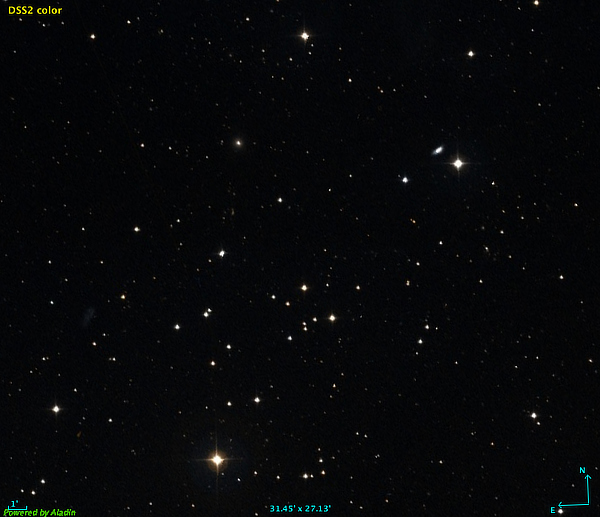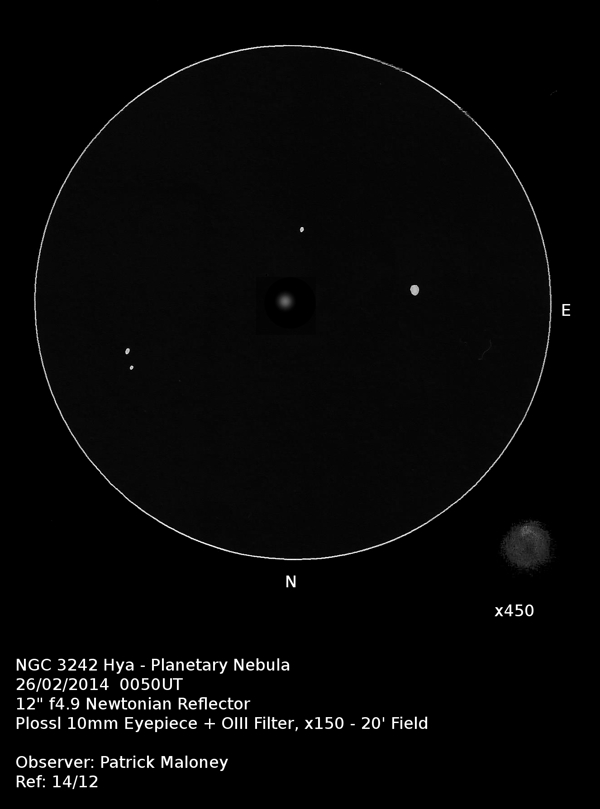A Remnant and a Ghostly Nebula
March 2021 - Nebula and Cluster of the Month
With the coming of Spring, the night side of the Earth begins to look away from the Milky Way and the deep-sky objects that lie within it. The time of the galaxies is arriving. There are consequently very few nebulae and clusters available to us. Open clusters are particularly scarce this month, but I can bring you details of one.
NGC 3231 lies in Ursa Major, about 6.4° north-west of α UMa. It was discovered in 1832 by John Herschel, who described it as A cluster of 20 stars more or less, 10, 11 and 12m, scattered over a space 10’ diam. A star 7 m s.

The seventh magnitude star south of the cluster is 7.9 magnitude SAO 15184 (HD 90318). Placing this star south of the cluster rather than south-west indicates that Herschel considered the cluster rather larger than modern images suggest. His diameter of 10' confirms this. Modern estimates are closer to 4'. As with any cluster, though, it depends on which stars you count. To my eye, the concentration of brighter stars to the east looks like the cluster, the fainter stars further west look more like background objects. Without proper spectroscopic and proper motion studies, though, it’s quite impossible to say what is and what isn’t a member.
The stars that I can find proper motions for all seem to be travelling in different directions, suggesting that NGC 3231 is no more than an asterism. Still, it's a nice little object to come across in the cluster-starved skies of March.
For the adventurous deep-sky observer with good skies and plenty of aperture, the very dim galaxy UGC 5671 lies about 10' to the west of NGC 3231.
For this month’s nebula, we’re travelling much further south, to Hydra, and to a considerably more impressive object. NGC 3242 is a magnitude 7.7 planetary nebula, big and bright but for northern observers blighted slightly by a fairly low declination of -18°. Fortunately, the object is bright enough to be visible even from poor skies.
NGC 3242 was, predictably, discovered by William Herschel on 7th February 1785, who described it as Beautiful, brilliant, planetary disk ill defined, but uniformly bright, the light of the colour of Jupiter. 40” diameter.
One of the principal attributes of this object is its distinct blue colour, which makes William’s description of it as being the colour of Jupiter
rather odd. Kent Wallace, in Visual Observations of Planetary Nebulae, describes its colour twice, once as pale green and once as green.
William’s son, John Herschel, in his magnum opus Cape Observations, makes the following comment: “A most remarkable peculiarity of the planetary nebula, … h. 3248 [NGC 3242], but which cannot be represented in an engraving, is its very decided though pale blue colour, which is noticed in three out of the four observations recorded in the sweeps. This and the beautiful planetary nebula h. 3365, [NGC 3918 in Centaurus] in which the blue colour is much more striking and intense, are the only objects of that colour in the heavens so situated as to admit of no suspicion of contrast with a red star influencing the eye. It is true that in the latter instance a considerably bright red star is near, and may be brought into the same field of view, and that is its presence greatly enhances the tint of the nebula. But the star is remote enough to be easily excluded, and the nebula does not cease thereby to appear of a fine blue colour.”
Reading this, I’m interested to note that neither of my observations of this object note any colour. This may have been due to the use of an OIII filter.
Its flattened disc and apparent diameter of about 40” present a view very similar to a dim Jupiter, which led William Nobel in 1887 to coin the name ‘The Ghost of Jupiter’ for this object.
This is a wonderful object in almost any sized telescope. My observation from 2014 reads Very, very bright. The object responds well to the OIII filter. At x150 the nebula is clearly slightly elongated and there are hints of annularity. At x450 a darker centre is seen, with a brighter patch on the south side of the nebula. A thin outer area of pale nebulosity can also be seen. Amazing.

The magnitude of the central star is quoted in the Deep-Sky Field Guide to Uranometria as 12.1, and comparable magnitudes are given elsewhere. I have never seen it, and I know several other observers who have failed to see it, even with larger telescopes than mine. This magnitude must surely be wrong.
Distance measurements for planetary nebulae are always a bit uncertain, but NGC 3242 seems to be about 1400 light-years distant, giving it a true diameter of around half a light-year.
| Object | RA | Dec | Type | Magnitude |
|---|---|---|---|---|
| NGC 3231 | 10h 28m 24s | +66° 42’ 38” | Asterism? | Br st =10.7 |
| NGC 3432 | 10h 25m 44s | -18° 44’ 38” | Planetary nebula | 7.7 |